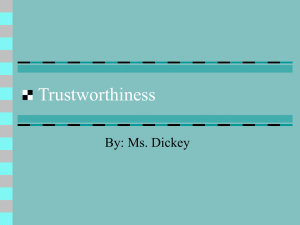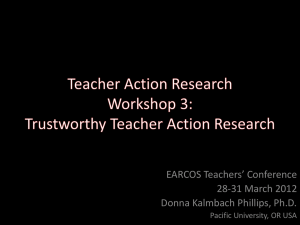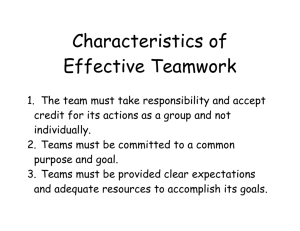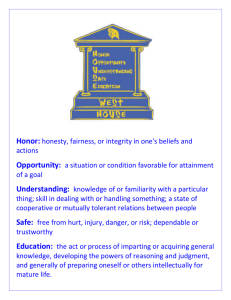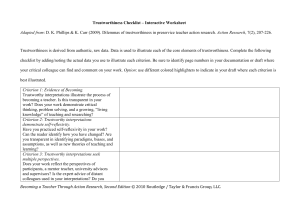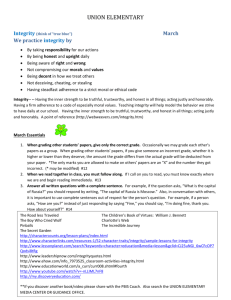Are You a Trustworthy Person
advertisement
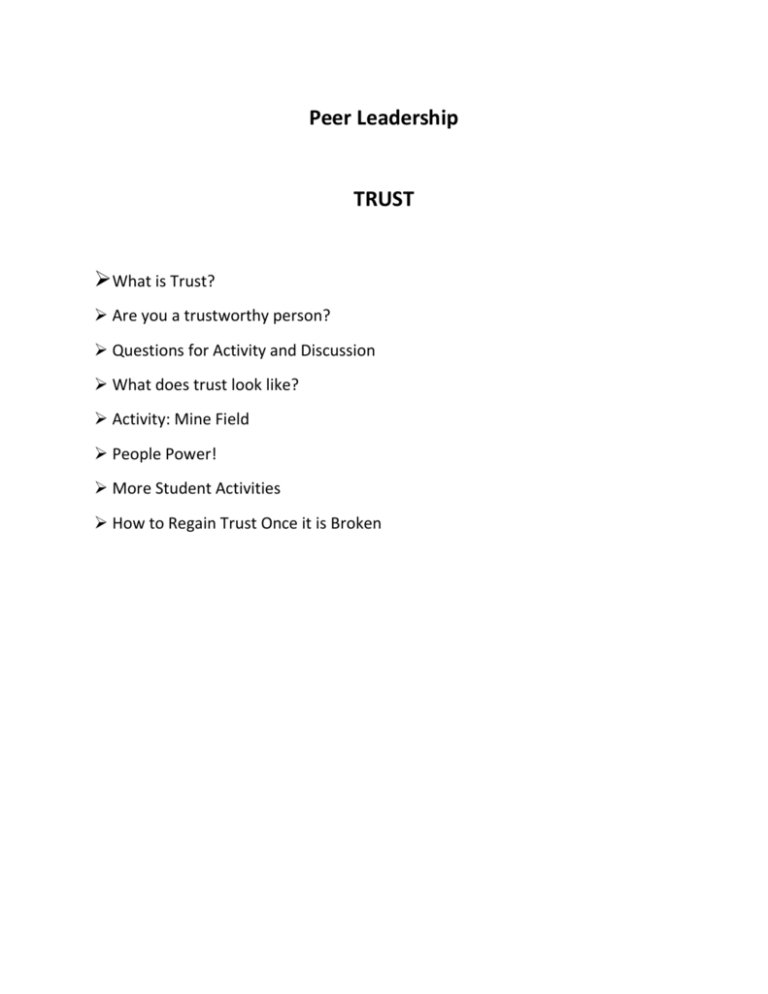
Peer Leadership TRUST What is Trust? Are you a trustworthy person? Questions for Activity and Discussion What does trust look like? Activity: Mine Field People Power! More Student Activities How to Regain Trust Once it is Broken What is trust? http://changingminds.org/explanations/trust/what_is_trust.htm Trust is both and emotional and logical act. Emotionally, it is where you expose your vulnerabilities to people, but believing they will not take advantage of your openness. Logically, it is where you have assessed the probabilities of gain and loss, calculating expected utility based on hard performance data, and concluded that the person in question will behave in a predictable manner. In practice, trust is a bit of both. I trust you because I have experienced your trustworthiness and because I have faith in human nature. We feel trust. Emotions associated with trust include companionship, friendship, love, agreement, relaxation, comfort. There are a number of different ways we can define trust. Here are the dimensions of trust and consequent definitions. Predictability It is a normal part of the human condition to be constantly forecasting ahead. We build internal models of the world based both on our experiences and what others tell us, and then use these to guess what will happen next. This allows us to spot and prepare for threats and also make plans to achieve our longer-term goals. The greatest unpredictability is at 50%; a reliable enemy can be preferable to an unpredictable friend, as at least we know where we are with them. Definition 1: Trust means being able to predict what other people will do and what situations will occur. If we can surround ourselves with people we trust, then we can create a safe present and an even better future. Value exchange Most of what we do with other people is based around exchange, which is the basis for all businesses as well as simple relationships. At its simplest, it is exchange of goods. I will swap you two sheep for one cow. It is easy to calculate the value in such material bargaining. Things get more complex when less tangible forces come into play. A parent exchanges attention for love. A company exchanges not only pay but good working conditions for the intellectual and manual efforts of its workforce. Value exchange works because we each value things differently. If I have a whole flock of sheep but no milk, then I can do business with a person who has a herd of cows but no clothes. This principle of reciprocity is what binds societies together. Trust in value exchange occurs when we do not know fully whether what we are receiving is what we expect. When we buy a car, don’t want to be sold a ringer which the seller knows is faulty. When I get advice in business, I want it to be based on facts, not wild opinions. Definition 2: Trust means making an exchange with someone when you do not have full knowledge about them, their intent and the things they are offering to you. Delayed reciprocity Exchange is not just about an immediate swapping of cows and sheep or hugs and kisses. What makes companies and societies really work is that something is given now, but the return is paid back some time in the future. The advantage of this is that we can create a more flexible environment, where you can get what you need when you need it, rather than having to save up for it. Trust now becomes particularly important, because otherwise we are giving something for nothing. The delay we have placed in the reciprocal arrangement adds a high level of uncertainty which we need to mitigate through trust. What is often called the ‘golden rule’ is a simple formula for creating trust. ‘Do unto others as you would have them do unto you.’ It sets up the dynamic for my giving you something now with the hope of getting back some unspecified thing in the indeterminate future. Definition 3: Trust means giving something now with an expectation that it will be repaid, possibly in some unspecified way at some unspecified time in the future. Exposed vulnerabilities When we trust other people, we may not only be giving them something in hope of getting something else back in the future, we may also be exposing ourselves in a way that they can take advantage of our vulnerabilities. If I buy a car from you and I do not know a good price, you can lie to me so you get a better bargain. If I tell you in confidence about the problems I am having with work, you could use this to further your own career at my expense. Although the threat of retribution or projected feelings of guilt can counteract your temptation to abuse my exposed vulnerabilities, if you succumb I still get hurt and may still end up with the shorter stick. For our transaction to complete successfully, I must be able to trust that such agonies will not come to pass. Definition 4: Trust means enabling other people to take advantage of your vulnerabilities—but expecting that they will not do this. So what? So learn about trust, how it works and how to build it. If you do it well, other people will give you the earth. If you betray them, they will hunt you to the ends of the earth. Are You a Trustworthy Person? (Take this self-evaluation and decide for yourself.) True False I keep my promises; I am a person of my word. I am reliable; I follow through on commitments. I am honest I keep secrets; I never betray a confidence or a trust. I have integrity; I don't cave in to temptation. I am loyal when loyalty is appropriate. I think I am/am not a trustworthy person because: ________________________________________________________________________________ ________________________________________________________________________________ _______________________________________________________________________________ Questions for Activity and Discussion 1. How do you know when you can trust someone? 2. Some adults say that your generation cannot be trusted, that you've lost the values from past generations. Do you agree, or disagree? 3. Is it a good idea to risk losing your parents' trust for temporary pleasure? Some people might say: "So what if you're in trouble for a little while?" Do you agree or disagree with this position? 4. How important is trust in your relationships with friends and family? How would these relationships be affected if you found out someone was lying to you? 5. Once trust has been broken, what can you do to get it back? Have you ever lost someone's trust? Has someone lost your trust? Explain. 6. If your friends were here right now, would they say you were trustworthy? What would your parents say? Are you more trustworthy with your friends or with your parents? Do you think your parents should trust you automatically? Why or why not? 7. What does trustworthiness mean to you? 8. If you want someone to trust you, who has most of the responsibility— you or the other person? Why? 9. Your trustworthiness may be questioned but your choices will never lie. What does that mean? Do you agree? 10. As a general policy, should we start off trusting people and only stop trusting if they prove that they're not worthy? Or should we be cautious and not trust them until they prove themselves worthy? What are the advantages and disadvantages of each position? 12. "Trust is the basis for every relationship." Do you think this is true? Explain. 13. Your willingness to trust another person is important if you want that person to trust you. Do you agree? Explain. 13. What does being trustworthy have to do with the quality of your character? 14. What are the benefits of being a trustworthy person? How do you benefit from the trustworthiness of others? http://www.leadership-tools.com/team-building-lesson-plan.html What does Trust look like? Goal of Activity: o Drawing a value or emotion Age Level: o All Ages Suggested Time Allowance: o Variable Objective: o To express or represent a feeling or value in a drawing Activities: o Participants write the theme on paper and draw what the theme looks like with pen, pencil, markers, and/or crayons. o Each individual will share their drawing and how it represents TRUST. o Students will discuss works created by other participants. Materials o Drawing paper and drawing supplies Closure: Leaders will facilitate a discussion on how the drawings represent a multifaceted definition of what TRUST is. Each drawing should represent how TRUST is interpreted by each individual. Leaders should emphasize the main themes uncovered as well any individual traits. Come with prepared discussion questions. Activity: Mine Field Description: Communication & Relationship-Building Activity (Trust) A popular and engaging game involving communication and trust. The task is very flexible, works for groups of various types and sizes, and can be adapted to youth, adults, corporate, etc. Select an appropriate area. Go outside, if possible. Can be done inside, even in rooms with fixed furniture (which can become objects to be avoided). Distribute "mines" e.g., balls or other objects such as bowling pins, cones, foam noodles, etc. Establish a concentrating and caring tone for this activity. Trust exercises require a serious atmosphere to help develop a genuine sense of trust and safety. Participants operate in pairs. Consider how the pairs are formed - it's a chance to work on relationships. One person is blind-folded (or keeps eyes closed) and cannot talk (optional). The other person can see and talk, but cannot enter the field or touch the person. The challenge is for each blind-folded person to walk from one side of the field to the other, avoiding the "mines", by listening to the verbal instructions of their partners. Allow participants a short period (e.g., 3 minutes) of planning time to decide on their communication commands, and then begin the activity. Be wary of blindfolded people bumping into each other. The instructor(s) can float around the playing area to help prevent collisions. Decide on the penalty for hitting a "mine". It could be a restart (serious consequence) or time penalty or simply a count of hits, but without penalty. It can help participants if you suggest that they each develop a unique communication system. When participants swap roles, give participants some review and planning time to refine their communication method. Allow participants to swap over and even have several attempts, until a real, satisfied sense of skill and competence in being able to guide a partner through the "minefield" develops. The activity can be conducted one pair at a time (e.g., in a therapeutic situation), or with all pairs at once (creates a more demanding exercise due to the extra noise/confusion). Can be conducted as a competitive task - e.g., which pair is the quickest or has the fewest hits? The facilitator plays an important role in creating an optimal level of challenge, e.g., considers introducing more items or removing items if it seems too easy or too hard. Also consider coaching participants with communication methods (e.g., for younger students, hint that they could benefit from coming up with clear commands for stop, forward, left, right, etc.). Be cautious about blind-folding people - it can provoke trust and care issues and trigger post-traumatic reactions. Minimize this risk by sequencing Mine Field within a longer program involving other get-to-know-you and trust building activities before Mine Field. People Power! Purpose of this activity: To build trust and rapport among team members by providing a team building lesson plan exercise that will open dialogue and build strong working relationships. Explanation: In an effort to build added trust and rapport, have each of your team members take a sheet of paper and write down the following facts: 1. List three words that they feel best describe their public identity. (Try not to give away too much so that you are easily identified.) 2. List any particular skill or talent that you possess that no one in the workplace is currently aware of. 3. Name 2-3 things that you aspire to learn or experience during high school. The leader will collect all of the sheets and post them on the wall. The leader must assign a number to each of the sheets as a reference point. Next, have each team member write down the names of all of their peers and then try to match the names of their peers with the correct numbered sheet that is posted on the wall. Once everyone has finished, the leader will lead a discussion asking team members to identify their sheet. Ask each team member to elaborate on his or her special skill or talent. Inquire what has motivated their high school/life goals, etc. In conclusion, the team leader can make a point of recognizing the "collective talent" in the room. They may even find that some unknown talent can now be used to help the team in a current or future project. Learning new things about team members is a great way to further strengthen trust and rapport between team members. MORE STUDENT ACTIVITIES 1. Divide the class into small groups. Have each group develop a list of do’s and don’ts for being a trustworthy person. (Have a pre-determined list of your own based on your research.) Have them make oral reports to the class addressing the following questions: What happens when people live in accordance with these guidelines? What happens when they don’t? In what ways does trustworthy and untrustworthy behavior affect our community and society? In what ways can/do young people demonstrate trustworthiness? 2. Have the students watch a movie, TV drama or sitcom, (or read a dialogue or story) paying particular attention to the behavior of the main characters with regard to trustworthiness. How much trustworthy behavior did they find? How much untrustworthy behavior? Have a class discussion about these issues. (A great many TV plots are based on a deceit.) 3. Most people consider loyalty to be an important part of trustworthiness. What, exactly, is loyalty? Who should be loyal to whom or what, and under what circumstances? When is loyalty appropriate, and when might it be a bad thing? Give some specific examples. Break the class into small groups to ponder these issues and have each group give an oral report to the class. http://www.goodcharacter.com/ISOC/Trustworthiness.html How to Regain Trust Once it is Broken At some point, a friend or someone you are close to may do something that breaks down the trust you have in him/her. This could be going against what you’ve asked them to do, betraying your confidence or lying to you. When these things happen it can be difficult to let go of hurt feelings caused by the harmful incident in order to regain trust. Even so, in many relationships it is worth it to try. Here's How: 1. Talk to the person about the incident. Let him/her know that you have lost your trust in his/her ability to _________________ (tell the truth, be supportive, etc.) Make it clear that he/she will need to take steps to regain the trust you had. 2. Let go of the personal hurt feelings as best you can. People generally don’t do things with the intent on hurting someone else. The better you are able to move away from your wounded self, the easier it will be to regain trust. 3. Keep communication open so that you and the other person have a mutual understanding of where the relationship stands and where you want it to go. For instance, make sure when you have questions about something, go directly to the person instead of consulting someone else. Don’ t believe “hearsay” from other people, clear communication is essential! 4. Hold up your end. This is sometimes hard, but trust is a two-way street. If you tell another person you are going to do something, you need to do it. Once your trust has been betrayed it may be tempting to fight back with revenge by hurting them right back. This “eye for an eye” mentality can only lead to more hurt and deceit. 5. Give it time. In time, knowing that the other person has done positive things since the harmful incident, you will be able to trust him/her again.
